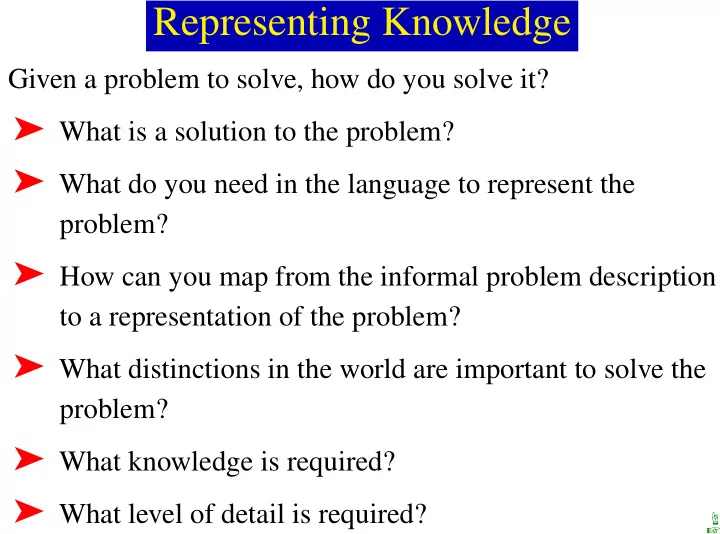

Representing Knowledge Given a problem to solve, how do you solve it? ➤ What is a solution to the problem? ➤ What do you need in the language to represent the problem? ➤ How can you map from the informal problem description to a representation of the problem? ➤ What distinctions in the world are important to solve the problem? ➤ What knowledge is required? ➤ What level of detail is required? ☞ ☞
➤ What reasoning strategies are appropriate? ➤ Is worst-case performance or average-case performance the critical time to minimize? ➤ Is it important for a human to understand how the answer was derived? ➤ How can you acquire the knowledge from experts or from experience? ➤ How can the knowledge be debugged, maintained, and improved? ☞ ☞ ☞
Knowledge representation framework solve problem solution informal interpret represent formal compute output representation ☞ ☞ ☞
Defining a Solution ➤ Given an informal description of a problem, you need to determine what would constitute a solution. ➤ Typically much is left unspecified, but the unspecified parts can’t be filled in arbitrarily. ➤ Much work in AI is motivated by common-sense reasoning. You want the computer to be able to make common-sense conclusions about the unstated assumptions. ☞ ☞ ☞
Quality of Solutions Does it matter if the answer is wrong or answers are missing? Classes of solution: Optimal solution the best solution according some measure of solution quality. Satisficing solution one that is good enough, according to some description of which solutions are adequate. Approximately optimal solution one whose measure of quality is close to the best theoretically possible. Probable solution one that is likely to be a solution. ☞ ☞ ☞
Decisions and Outcomes ➤ Good decisions can have bad outcomes. Bad decisions can have good outcomes. ➤ Information can be valuable because it leads to better decisions: value of information. ➤ You have to trade off computation time and solution quality: an anytime algorithm can provide a solution at any time; given more time it can produce better solutions. You don’t only need to be concerned about finding the right answer, but about acquiring the appropriate information, and computing it in a timely manner. ☞ ☞ ☞
Solution quality and computation time time independent quality time-dependent value time discount quality 0 5 10 15 20 time ☞ ☞
Recommend
More recommend